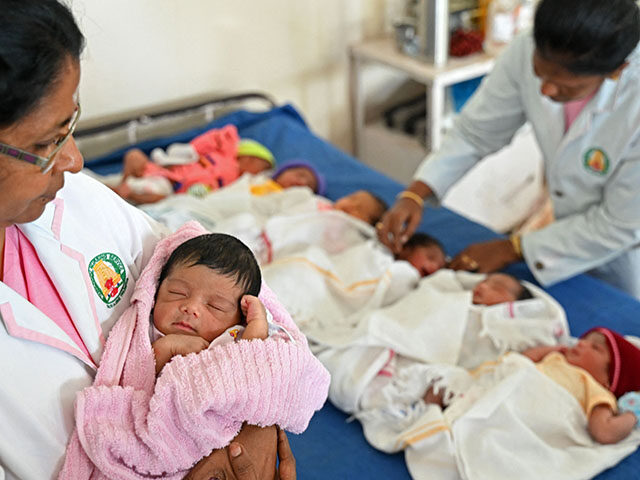The United Nations marked World Population Day on Tuesday, publishing a forecast that the Earth’s population will hit 9.7 billion by the year 2050 and surpass 10 billion before the end of the century.
The report was laced with delicately expressed anxiety that the surging populations of African nations might develop Western-sized carbon footprints, overwhelming even the most extreme plans to control the world’s climate.
The Emitari newspaper the National put the U.N.’s population concerns rather bluntly:
More than half of world population growth until 2050 is expected to occur in Sub-Saharan Africa, where the most recent World Bank figures indicate that average annual carbon emissions are about 0.7 tonnes per person per year, compared to the global average of 4.3 tonnes.
As a result, population growth in the coming decades may have less of an impact than it would have had, had it been happening in richer regions.
Raya Muttarak, professor of demography at the University of Bologna in Italy, said the real challenge of dealing with climate change is reducing consumption in richer parts of the world.
“What’s really interesting is that the lowest-income group in the US still emits carbon more than the highest-income group in Africa,” she said.
RELATED VIDEO — Climate Protesters Arrested After Defacing Italian Fountain, Crowd Cheers After Fountain Reopens:
Celebrating a huge number of human beings being born into grinding poverty, food insecurity, primitive living conditions, and incessant violence is not a good look for the climate change movement, so the U.N. report was accompanied by musings that the people of developed nations should think about reducing their carbon footprints to sub-Saharan African levels. This does not seem like a course the people of North America, Europe, and industrialized Asia would pursue voluntarily.
An alternative approach floated by population experts would be reducing African birthrates by exporting some of the same cultural and political factors that have locked many advanced nations into demographic death spirals. The U.N. suggested “policies that promote gender equity” as one such fertility-killer, because “women with greater freedom typically choose to have fewer children.”
The National’s correspondents implied one means of incubating these low-fertility ideals would be bringing large numbers of people from the Third World into Europe and America, where they will serve as replacement labor for the young Europeans and Americans who have not been born.
This seems like a risky proposal from the climate change perspective because imported populations are likely to acquire larger carbon footprints much faster than they inherit cultural trends that drive birth rates down. The U.N. seems to be gambling that ready access to better education, contraceptives, and abortion will produce immediate downward pressure on birth rates for economic migrants:
Realizing sexual and reproductive health and rights for all is the foundation for gender equality, dignity and opportunity. Nevertheless, over 40 per cent of women around the world cannot exercise their right to make decisions as fundamental as whether or not to have children. Empowering women and girls, including through education and access to modern contraception, helps to support them in their aspirations — and to chart the path of their own lives.
Advancing gender equality is a crosscutting solution to many population concerns. In ageing societies that worry about labor productivity, achieving gender parity in the workforce is the most effective way to improve output and income growth. Meanwhile, in countries experiencing rapid population growth, women’s empowerment through education and family planning can bring enormous benefits by way of human capital and inclusive economic growth.
RELATED VIDEO — Climate Strikers HAULED OFF by Police in Berlin:
India’s population is growing rapidly as well as Africa’s, which could pose a problem for global population planners because India’s economy is developing rapidly, India is not shy about securing as much energy as it needs to give that population a higher standard of living, and India’s culture has proven resistant to the cultural and technological forces that push birth rates down in other developed nations.
Indeed, Indian Prime Minister Narendra Modi’s “New India” program explicitly promises to boost India’s industrial power and improve the lifestyles of its citizens while preserving traditional Hindu culture.
AfricaNews chose to express this challenge by saying that India and Africa’s surging populations could “face the brunt of climate change,” rather than warning they might cause it.
“70% of Africans are under the age of 30, and this is happening while many of the developed world, the developed nations, are experiencing a rapidly aging population,” observed Africa Program Chatham House Deputy Director Tighisti Amare.
“The population growth is, of course, partly explained by improvement in level and access to public health. That has led to a decrease in child mortality. And that by itself is good news,” Amare continued.
“And the other good news is that also by having a young population, most African nations do not have the burden of a large elderly population that relies on taxes and pensions, which can be a strain on the economy as well,” she concluded.
Amare is undeniably correct in these observations, but her prognosis raises the question of what happens when that young, dynamic African workforce – free of the crushing demographic burden that will soon begin destroying social welfare systems in the U.S., Europe, and China – begins demanding more energy to fulfill its dreams, far beyond the amount of industrial power the climate change movement is willing to let them have.

COMMENTS
Please let us know if you're having issues with commenting.